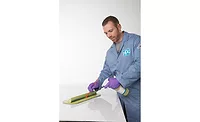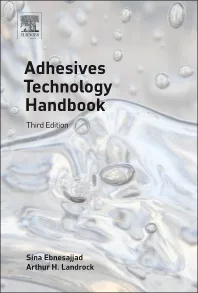Aerospace Sealant: A Positive Partnership
Two companies collaborate to develop a new aerospace sealant and meter-mix process solution.
Formulators continuously partner with customers to create customized solutions for specific applications, as well as tailored packaging and equipment to smoothly integrate into the customer’s assembly process. This developmental process forges a partnership between the two companies.
Formulators derive a significant portion of their revenue from primary-source relationships. Even though the quality and efficacy of a formulator’s products and packaging solutions are critical to the ultimate performance of its customer’s end products, it typically represents only a small percentage of the customer’s overall product costs. With this in mind, Adhesive Packaging Specialties (APS), in conjunction with its parent company Royal Holdings Inc., brought to market a next-generation, high-technology polysulfide sealant program for the aerospace industry.
Evolution of Polysulfide Sealants
Because of their excellent resistance to fuel and chemicals, polysulfide sealants are widely used in various aerospace applications where strong chemical and UV resistance is required. Specifically, aircraft applications that specify polysulfide sealants include integral fuel tank sealing, cabin pressurization and console inhibition sealing, electrical encapsulation in fuel tanks, window sealing, access door sealing, and form-in-place gasketing.
Historically, polysulfide sealants were not fast cure or lightweight. In fact, they were almost 60% heavier than the current generation of polysulfide sealants. Moreover, older-generation corrosion-inhibitive polysulfide sealants contained harsh chemicals such as chromates and solvents.
In addition to being fast cure and lightweight, new-generation polysulfide sealants have other advantages, such as non-chromate corrosion inhibition, and higher temperature and fatigue resistance. Flexibility and performance in extreme conditions and environments are key attributes of polysulfide sealants.
The competitive landscape in the aerospace polysulfide sealant industry is changing. For many years, only a few formulators controlled the aerospace polysulfide sealants market. Many aircraft OEMs, aircraft subcontractors and defense OEMs were looking for alternate aerospace sealant suppliers, and Royal acted on this opportunity to become a global partner with an aircraft OEM.
In addition to the formulated product’s performance, many of the global aircraft manufacturers in the past decade have looked for stronger supplier partnerships. These partnerships, which exceed the traditional supplier/customer relationship, include packaging, logistics and training services.
In the aerospace and defense industry, lightweight materials such as composite and other polymeric materials have continued to replace heavier metal components in an effort to increase overall fuel efficiency. Today’s global trends in aircraft production require high-performance, lighter-weight materials.
Developing the New Sealant
With this in mind, Royal set out to develop a high-performance sealant. Using its pre-mix and frozen packaging and logistics capabilities, APS designed an advanced technology proprietary meter-mix process.
Royal collaborated with a global aerospace company to develop the new product solution. The project objective was to develop a lightweight, fast-cure, non-chromate corrosion-inhibitive fuel and fuselage sealant that complied with global environmental standards. Royal worked closely with the customer’s research team to develop and qualify a sealant that met all of the specification requirements. APS was brought into the process during the later stages, when Royal needed to provide the product in pre-mix and frozen to finalize qualification and meet production and logistics needs.
Formulators and value-added packagers face several challenges when introducing new products. While it is a partnership, the customer still drives the development of the new technology. APS and Royal ensured that the new product met the customer’s needs and was qualified to the customer specifications. The new product was judged on quality, affordability, service and performance. In the case of polysulfide aerospace sealants, the performance must be light weight, fast cure, and fuel- and corrosion-resistant. In addition, the new polysulfide product needed to be chromate- and solvent-free, thereby improving its environmental health and safety characteristics.
APS and Royal must also continue to develop and introduce new products to meet the customer’s future needs. In addition, there must be a packaging, logistics and added-value services aspect to the product that weds the installer to the product.
Processing Innovations
Polysulfide sealants are processed into pre-mixed and frozen by using meter-mix machines, which pump, proportion, mix, and dispense the sealant into cartridges. However, the technological advances with this new sealant were not compatible with traditional meter-mix equipment. Royal and APS needed to develop a new, proprietary meter-mixing process specifically designed to meet the demands of this advanced sealant for the aerospace industry.
The traditional meter-mix process takes the base and catalyst, which are pumped into metering sleeves. The metering sleeves send the right proportions to the mixing head without affecting the critical properties of this demanding product. Next, the sealant is mixed and filled directly into the cartridges in precise volumes. It is imperative to ensure that the sealant is air free; excess air in the cartridge at the start of the fill is carefully bled out, and the process is monitored to ensure that no air is incorporated into the mix or cartridge.
Once filled, the cartridge is passed to the second operator, who places a small sample of each cartridge, called a button, on a button board. Each cartridge is individually numbered and corresponds to a square on the button board. These buttons are part of the in-process quality assurance and are used to check for uniformity, cure consistency, and any air entrapment.
After the button sample is taken, the cartridge is capped and immediately placed in a freezing bath at -70°F. The cartridges stay in the freezing bath for a minimum of 10 min to reach a frozen state that stops the curing reaction.
When the sealant is frozen and ready to come out of the bath, the operator quickly transfers the sealant into bins, which are labeled and put into a -70°F storage freezer until they are packed and shipped. Cartridges are packed into coolers with dry ice to keep them frozen throughout the shipping process.
While the overall process is the same, APS developed certain techniques needed to compensate for the unique nature of the polysulfide sealant properties. The lightweight and compressible nature of the new-generation sealant created the challenge that required a new way of processing. Existing mixing equipment became incompatible with the new sealants, and special metering and dispensing improvements needed to be incorporated into the mixer design. Lightweight, fast-cure, and chromate and solvent-free properties all drove a significant change in the pre-mixed and frozen sealant process.
Partners for Change
APS developed a customized global logistics system to provide pre-mix and frozen sealant in point-of-use cartridges for delivery directly to production lines for intricate fuel and fuselage sealing applications. Royal and APS received a five-year global contract in mid-2014 for all the customer’s aircraft models at all global locations.
Royal and APS are now embedded in the product innovation and development lifecycle of the aerospace customer, and are a major partner at each step in the process to address its customer’s needs. In addition, Royal is expanding in the market and providing even more innovative products and packaging to other aerospace customers.
For more information, call (800) 222-1117, email sales@adhesivepackaging.com or visit www.adhesivepackaging.com.
Looking for a reprint of this article?
From high-res PDFs to custom plaques, order your copy today!





